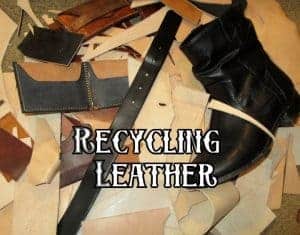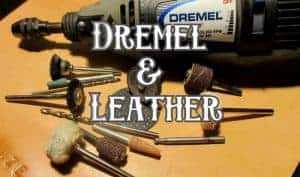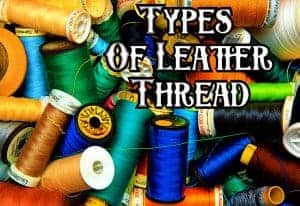
Burnishing Leather Edges Guide
A burnishing leather edges guide is one of the first things I looked for when I started leatherworking. I soon found out that burnishing leather edges was one of the quickest ways to make my projects look professional.
It’s surprisingly easy to burnish leather edges if you have the right tools. But I’ve even used water and a simple wood slicker without any problem. So you don’t need anything fancy to get started.
Need to Know to Get Slick and Sleek
All you need to burnish leather edges is a slicker and a lubricant. While I find that water is okay, I prefer gum tragacanth. As for the slicker, a wood slicker is my favorite because it has great results and is easy to control.
My favorite wood slicker is similar to the Tandy Leather Slicker. As for the gum tragacanth, I’ve had no problem using Fiebing’s Gum Tragacanth, which is cheaper than most other brands.
As for the process, it’s quite easy. While there are other steps you may take, the only ones that are really necessary are applying the lubricant and using the slicker to burnish the edges.
Why Burnish Leather Edges?
I’ve seen videos of leatherworkers finishing their project without burnishing edges. However, I don’t recommend it. If you want to create a cover along the edge, then you can get by without burnishing, but that strip would look better burnished anyway.
To Make It Look Nice
This is the main reason most leatherworkers slick their edges. It looks so much nicer whenever the edges are smooth. There are no stray fibers, the edges are darker, and it seals them prettily.
To Prevent Rot

A lot of leatherworkers slick their edges without even realizing how important it is to prevent rot. But whenever you use a lubricant and slicker to seal the edges, the fibers won’t come undone, and it wards off moisture.
To Prevent Shredding
This is along the same lines as the other two, but I want to point it out because shredding leather annoys me. I have even found that running the point of the slicker along holes is helpful to prevent this.
What You Need to Burnish Leather Edges

Not everything on this list is completely necessary, but this is what I use to burnish leather edges. If you only have water and a wood slicker, that’s fine. But I suggest collecting all of these over time.
- Lubricant – lubricant is the second most important tool for burnishing leather edges. I will expand on lubricants later, but you can use water, gum tragacanth, or another lubricant.
- Burnishing Tool– the slicker or burnishing machine is what you will use after you rub the lubricant on. This is the most important tool because it does 90% of the work. But don’t try to use it without a lubricant, or you won’t get anywhere.
- Sandpaper – sandpaper is optional, but it’s helpful if you have a lot of stray fibers or if you made some rough cuts. This will smooth down most leather edges so that your burnishing phase will go quickly.
- Top Coat – a top coat, or conditioner, will further seal and protect the edges. This isn’t necessary, but it’s helpful to add it over the entire leather piece whenever you finish the edges. But make sure you don’t condition before you dye.
- Bevel – a bevel can help shape the edges and make them look even smoother. Always bevel before you slick. However, you can bevel before or after using sandpaper as long as the bevel is sharp.
Types of Leather Lubricant
There are more than a dozen types of lubricant that you can use. However, I prefer to stick with my favorites. If I’m in a pinch, I will pick an alternative up from the grocery store.
The purpose of the lubricant is to help the stray fibers slick down. My favorite lubricant is gum tragacanth because it’s natural, works well, and is affordable. I also prefer the texture to a block because it keeps the edges moist, thus using less.
Water
Water works for burnishing leather edges but will require more work. You won’t be able to burnish in one go, you’ll have to make sure you keep reapplying water but don’t let it drip on the rest of the leather.
Trust me when I say that a drop of water can ruin the project. That’s the main reason I rarely use it. Other products are easier to wipe off, but water immediately soaks into unprotected leather.
Beeswax
Beeswax may be the oldest leather lubricant used by leatherworkers. It’s affordable, easy to find, and it smells amazing. It’s my second favorite type of leather lubricant, so I like to keep it on hand. Even if only to make my tool kit smell good.
When you have a solid lubricant like this, you can get a special tool for it. But I don’t recommend them. Instead, use a cloth or a slicker to apply the beeswax, as they are multipurpose and have stood the test of time.
Gum Tragacanth
Gum tragacanth is my favorite leather lubricant. It’s easy to use, affordable, and non-offensive to smell. It has a slight chemical smell (with a hint of cedar), but ignore that because most are 100% natural.
Gum tragacanth comes from the dried sap of Middle Eastern legumes. It’s also non-toxic, but I don’t recommend testing this out. I only mention it in case you’re running a 100% natural workshop.
Saddle Soap
It’s perfectly acceptable to use saddle soap just because you like the name. It’s slightly more expensive than other options, but it goes far because of the thick texture. I’ve never used it before, but I do hear good things.
Fiebing’s and Kiwi both have affordable options. You can use it just like you would beeswax. It comes in a can, so it’s a little more difficult to apply with a slicker, but cloth will work.
Burnishing Gum
Burnishing gum is the best and most expensive type of lubricant. Once I trust myself enough to make the most of it – and not spill it – I’m going to stock up on the Tokonole brand.
I’ve heard such great things about this, so I recommend you do your research and watch some videos of it in use. You won’t regret doing extra research when it comes to leatherworking.
Types of Burnishing Tools
The wood slicker and the burnishing machine are my top burnishing tools. I’m sure there are other viable options out there for burnishing, but these two are by far the most popular and my two favorites.
Wood Slicker
Wood slickers are my favorite type of burnishing tool. While you can get glass and plastic ones, I prefer the wood ones because they feel so natural. I use the classic pointed slicker, the flat kind, and the wheel.
Burnishing Machine
A burnishing machine is a luxury in the leatherworking world. Once you hook it up, you cut your burnishing time down significantly. I still don’t have one of these, but I will add one once I get my workshop built.
Dremel
A dremel is in-between the machine and the slicker. The dremel is a hand tool that you can either attach to the machine or use on an independent power tool. They work well but don’t give as much control.
How to Burnish Leather: Step-By-Step, Oh Baby

A step-by-step guide on how to burnish leather edges may be all you need now. If you have the tools ready, feel free to follow along. But I recommend reading through the steps before doing so.
Prep

Before you start burnishing leather, you should make sure all of the cutting, hole punching, and dying is done. Otherwise, you’ll have to redo something. Not to mention, your leather won’t dye well after you use a lubricant.
Step 1: Sand and Bevel (Optional)

Before applying any lubricant to the leather, bevel and sand it. The beveling will shape the leather edges and make them look professional. I recommend medium-grit sandpaper, but you can experiment depending on your leather type.
There are many different types of bevels, and it’s hard to understand what each is used for. So if you’re not ready for beveling, you won’t notice much if you skip out on it for now.
Step 2: Apply Lubricant

Apply the lubricant with a soft brush, perhaps a wool dauber or soft cloth, for best results. If you are using beeswax, that probably won’t work, so I recommend rubbing the slicker onto the beeswax block. Now, if your fingers are very clean, you can use them, but I don’t recommend it.
Step 3: Run Slicker

After the lubricant is applied, you should run the slicker over the edges quite quickly. Don’t let the edges dry out. Add more lubricant and slick over them every time they start to. Don’t be surprised if this takes a while.
I prefer to use a wood slicker because it gives me full control. It takes longer than an automatic one but leaves less room for mistakes. This is coming from someone who has a sewing machine but almost always chooses to hand stitch.
Step 4: Change Groove Size
I like to finish up by changing the groove size to be a little too large. That way, everything comes together. This is optional, but it’s a good way to safely finish up without compromising anything.
Step 5: Condition (optional)
The top coat is actually a conditioner that will protect the leather, so you can hold off on using it until you’re done with everything else. Just don’t forget to do so if you want your leather to last a lifetime.
I cannot recommend leather conditioner enough. I use jojoba oil or carnauba cream. The latter is sold at leather stores or on Amazon. I use Fiebing’s brand, but I’m sure any brand is fine and will come with a wool dauber.
FAQs
Question: Do I Dye or Burnish Leather First?
Answer: You should dye the leather first before burnishing, as the lubricant will seal the edges and resist the stain. This is a good thing, but it’s hard to remember since I always have it in my head to dye last.
Question: Why Do I Have to Burnish Leather Edges?
Answer: Burnishing leather edges prevents rot, keeps edges looking nice, and protects against stains. It’s not a step you should skip. But, once you get the hang of it, it doesn’t take long.
Question: How Do You Burnish Leather Without Tools?
Answer: You can use water and wood to burnish leather edges. It won’t work as well as other tools, but it will get the job done. Just remember not to use splintery wood and to keep the edges wet.
Question: What’s the Best Leather Burnishing Tool?
Answer: A wood slicker is the most common leather burnishing tool. They are cheap, effective, and last forever. You can get them in different shapes and sizes, but the classic round pointed one is the most popular.
Question: What’s the Best Brand for Leather Burnishing?
Answer: I find that Fiebing’s is the best for quality and cost. But if you’re looking for a good store to shop at, then Tandy Leather and Weaver Leather Supply are popular and affordable shops.
Leather Burnishing: Necessity
Burnishing leather edges is what I would like to call a necessity. If you don’t burnish the edges, the project will never look finished and will call to rot, ensuring the piece doesn’t live long.
If you find yourself making mistake after mistake, just know that you’re not alone, but it’s unlikely you’ll make a mistake when burnishing that you can’t repair. This is nothing like the process of cutting and dying.
It may take twenty minutes to burnish a medium-sized project, but once you get a flow going, it’s a piece of cake. If you want to take your time without compromising quality, then Netflix is always there for you.
For more interesting readings, check out:




